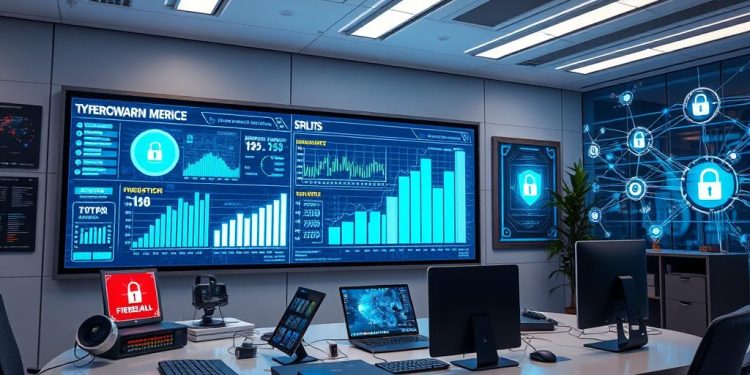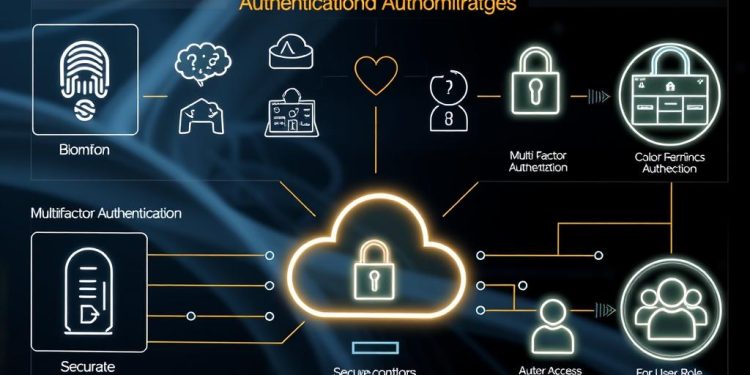In today’s digital landscape, application security has become an essential component in safeguarding against the ever-increasing prevalence of cyber threats. With the rising number of data breaches—like Microsoft’s revelation of over 250 million exposed customer records in 2020 and Keepnet Labs’ striking statistic of over 5 billion sensitive records compromised—it is critical for organizations to adopt robust protection tools. This article will explore various security monitoring tools tailored to enhance your application’s security posture, helping you identify vulnerabilities and react swiftly to potential threats.
Continuous Security Monitoring (CSM) tools play a pivotal role in this effort, collecting valuable data from sources such as network traffic and user activity to detect suspicious actions. By maintaining a proactive approach, organizations can not only prevent breaches but also comply with stringent regulations like GDPR and HIPAA. Implementing these tools allows businesses to minimize the ramifications of a data breach, which can lead to significant underperformance over time. Join us as we delve deeper into the top tools available for monitoring and enhancing application security.
Understanding Application Security and Its Importance
In today’s digital landscape, understanding the application security importance has become crucial for organizations of all sizes. With the rising frequency of cyber attacks, businesses face escalating risks that can result in devastating data breaches. The urgency to implement robust security practices cannot be overstated.
The Growing Frequency of Cyber Attacks
Recent statistics reveal that nearly 80% of organizations have reported experiencing a breach in the past year. Broken access control and injection flaws are often leading causes, highlighting that over 65% of security breaches stem from application vulnerabilities. Given that approximately 40% of all organizations face security vulnerabilities in their applications regularly, proactive security measures become vital to safeguard sensitive information.
Impact of Data Breaches on Organizations
The repercussions of data breaches are profound. Organizations can suffer extensive leaks of sensitive records, leading to significant long-term financial declines. On average, affected companies may experience a 15% drop in performance over three years. With the average cost of a data breach hovering around $3.86 million, it is evident that the stakes are high. Many breaches exploit known vulnerabilities, reinforcing the importance of timely patching and the application of current software to mitigate risks.
Benefits of Proactive Application Security Measures
Engaging in proactive application security measures can yield numerous advantages. Effective security controls have the potential to reduce vulnerabilities by up to 70%. By implementing continuous application security monitoring, organizations can facilitate rapid identification and remediation of security breaches. This proactive approach not only diminishes incident impact but can lower average breach costs by up to 50%. Successful threat modeling and the combination of logging, scanning, detection, and identification are integral components of a robust security framework.
Security Monitoring Tools: An Overview
Understanding the security monitoring landscape is essential for maintaining a strong defense against cyber threats. A comprehensive security monitoring overview encompasses various tools and approaches, with Continuous Security Monitoring (CSM) being a cornerstone of effective security practices. CSM continuously evaluates your organization’s security status by collecting and analyzing data from multiple sources, including network traffic and user behavior.
Datadog stands out as a leader in this domain, recognized in the 2024 Gartner® Magic Quadrant™ for Digital Experience Monitoring. Its security monitoring tool is designed to analyze security and observability data in real-time, allowing for immediate identification of potential threats and risks. The platform incorporates customizable rules mapped to the MITRE ATT&CK™ framework, enabling the tracking of common attacker techniques and ensuring thorough security oversight.
Utilizing a blend of metrics, logs, and traces within a unified platform, Datadog enhances operational efficiency by simplifying the visualization of security data. Security investigation dashboards can be easily tailored through a drag-and-drop interface, promoting streamlined analysis. Real-time alerts and reporting are integral features, providing immediate notifications about security incidents alongside detailed reports for deeper insights.
The importance of network security monitoring cannot be overstated. It helps identify unusual changes in access control policies that may indicate cyber threats. The capability of security tools to support compliance with standards like PCI DSS, HIPAA, and NIST is crucial, as organizations must ensure they meet regulatory requirements to mitigate risks effectively.
Below is a comparative table highlighting key aspects of some popular security monitoring tools:
| Tool | Key Features | Compliance Support | Trial Availability |
|---|---|---|---|
| Datadog | Real-time security analysis, integration with MITRE ATT&CK™, customizable dashboards | PCI DSS, HIPAA, NIST | 14-day free trial |
| Security Onion | Open-source network monitoring, strong community support | Limited | Free; community-based |
| ELK Stack | Advanced data visualization, scalable architecture | Limited | Free; community-based |
Ensuring that your organization harnesses the capabilities of powerful security tools is vital for an effective security posture. The enhanced visibility offered by continuous security monitoring helps you stay ahead of potential threats and maintain the integrity of your applications and infrastructure.
Top Tools for Continuous Security Monitoring
In the ever-evolving landscape of cybersecurity, organizations require robust continuous security monitoring tools to protect their systems and sensitive data. Various tools offer different capabilities to address security needs. Here’s an overview of the top options available today.
Best Overall Continuous Security Monitoring Tool: Jit
Jit stands out as a leading solution in the field of continuous security monitoring. Its robust orchestration capabilities allow for seamless integration with other security tools. This facilitates a unified approach to monitoring security threats and managing incidents. Utilizing Jit helps organizations stay ahead of potential breaches, improving overall security posture.
Monitoring for Vulnerabilities: Nagios and Splunk
Nagios and Splunk are two top contenders for vulnerability monitoring. Nagios is renowned for its reliability in overseeing server performance and network health. It provides real-time alerts for any unauthorized access attempts. Splunk excels in processing and analyzing large datasets, offering valuable insights into system vulnerabilities. Organizations leveraging Nagios and Splunk typically experience enhanced visibility and faster response times to security issues.
Managing Patch Deployment with Syxsense
Syxsense emerges as a leader in automating the patch management process. This tool simplifies the deployment of security updates across various systems, ensuring compliance and reducing vulnerabilities. By utilizing Syxsense, organizations can maintain a secure environment and protect critical data effectively.
| Tool | Key Features | Use Case |
|---|---|---|
| Jit | Orchestration, integration with other tools | Continuous monitoring and incident management |
| Nagios | Reliability, real-time alerts | Monitoring server performance and unauthorized access |
| Splunk | Data analytics, threat detection | Analyzing large datasets for vulnerabilities |
| Syxsense | Automated patch management | Efficient deployment of security updates |
Choosing the right continuous security monitoring tools is essential for minimizing risks and enhancing your organization’s security framework. Each tool offers unique capabilities that fit different needs. Prioritizing these tools enables effective management of vulnerabilities and helps maintain compliance with security regulations.
Application Security Tools for Developers
As software development continues to evolve, the importance of application security tools cannot be overstated. Developers require reliable options to protect their applications against various vulnerabilities. Open-source application security tools offer flexibility and cost-effectiveness, making them a popular choice for many development teams.
Key Features of Open-Source Application Security Tools
When selecting open-source tools, focus on those that provide essential features to optimize application security:
- Seamless Deployment: Tools that integrate easily within existing environments enhance developer productivity.
- Multi-Language Support: A diverse range of supported programming languages caters to different types of projects, ensuring flexibility.
- Real-Time Scanning: Immediate feedback on potential vulnerabilities allows for quicker resolutions.
- Up-to-Date Compliance Information: Regular updates regarding security standards help maintain compliance with industry regulations.
How Application Security Tools Assist in Secure Development
Application security tools promote secure development practices by fostering collaboration among teams. Utilizing these tools throughout the software development lifecycle (SDLC) enhances developer security in several ways:
- Rapid Vulnerability Identification: Quickly discovering vulnerabilities allows for timely fixing, preventing potential exploits.
- Integration Across Teams: Encouraging cooperation between development, operations, and security teams streamlines efforts to maintain security.
- Continuous Learning: Developers gain insights from security findings, fostering a culture of continuous improvement.
Enhancing Security with Vulnerability Detection and Penetration Testing
In today’s rapidly evolving cyber landscape, organizations face increasing threats that demand robust security measures. Vulnerability detection plays a key role in identifying and mitigating risks before potential exploits occur. Understanding and applying application security best practices is essential for maintaining the integrity of your systems. Implementing effective vulnerability detection methods can create a more fortified defense against cyber threats.
Best Practices for Vulnerability Detection
Establishing best practices for vulnerability detection ensures that your organization remains proactive in its security efforts. Key strategies include:
- Incorporate automated tools for real-time scanning to identify vulnerabilities as they emerge.
- Schedule regular scans to maintain a consistent overview of your security posture.
- Prioritize remediation efforts based on the severity of discovered vulnerabilities.
- Keep compliance data updated in light of new regulatory standards and emerging CVEs.
- Utilize tools such as SonarQube, which checks code against extensive rulesets, supporting over 29 programming languages.
The Role of Penetration Testing in Application Security
Penetration testing serves as a critical method for assessing your application’s defenses. By simulating real-world attacks, this process uncovers weaknesses that may not be revealed through standard vulnerability detection methods. Key elements include:
- Providing insights into potential exploit paths that cybercriminals could exploit.
- Offering detailed assessments that aid in hardening applications against threats.
- Facilitating an enhanced understanding of your security landscape, making it easier to implement effective application security best practices.
- Encouraging a culture of security awareness among development teams, leading to more secure coding practices.
Conclusion
In summary, the adoption of effective application security tools and comprehensive security monitoring practices is essential for shielding your organization from the growing wave of cyber threats. The global average cost of a data breach is projected to reach $4.22 million in 2024, making it vital for you to implement strong protection strategies. Continuous security monitoring not only helps minimize the risk of data breaches but also ensures compliance with ever-evolving regulations.
Utilizing solutions like SIEM can significantly enhance threat detection capabilities through real-time analysis and alerts. By combining multiple cybersecurity monitoring techniques, you can achieve a comprehensive protective layer across your systems, helping you mitigate potential financial losses and compliance fines. Proactively managing security means that you will not only reduce vulnerability but also foster greater trust and confidence among your users.
As the landscape of cyber threats continues to evolve, investing in the right tools and practices will bolster your defenses. With the right mitigation strategies, you can react promptly to potential threats and be a step ahead in this dynamic environment. Ultimately, prioritizing application security tools and security monitoring will lead to a more resilient and secure organization.










